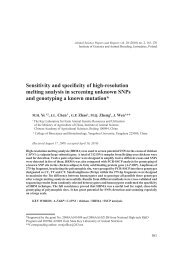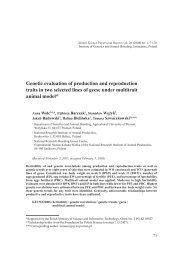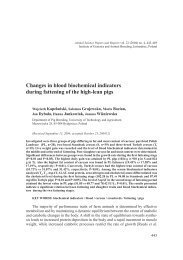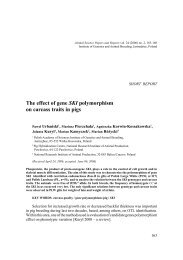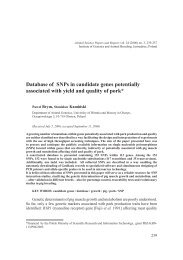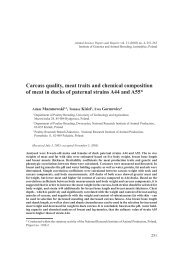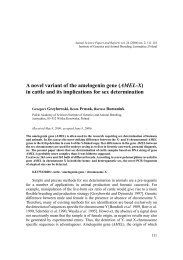Grazing as a tool to maintain biodiversity of grassland â a review
Grazing as a tool to maintain biodiversity of grassland â a review
Grazing as a tool to maintain biodiversity of grassland â a review
You also want an ePaper? Increase the reach of your titles
YUMPU automatically turns print PDFs into web optimized ePapers that Google loves.
E. Metera et al.<br />
In the c<strong>as</strong>e <strong>of</strong> intensive grazing practices, the opposite effect can be expected.<br />
Overgrazing affects soil properties resulting in reduced water infiltration, less soil<br />
moisture and fertility. It changes microbiological activity and incre<strong>as</strong>es soil erosion<br />
[Czeglédi and Radácsi 2005, Thurow 2005]. High grazing pressure decre<strong>as</strong>es plant<br />
diversity, changes the botanical composition <strong>of</strong> the sward and can lead <strong>to</strong> the inv<strong>as</strong>ion<br />
<strong>of</strong> undesirable plant species. For example, when grazing is intensive, bunch gr<strong>as</strong>ses<br />
tend <strong>to</strong> be eliminated. Intensive grazing leads <strong>to</strong> an incre<strong>as</strong>e <strong>of</strong> short gr<strong>as</strong>ses and<br />
annuals, which do not stimulate soil <strong>maintain</strong>ing because <strong>of</strong> their poor root system.<br />
There are many examples <strong>of</strong> the negative effect <strong>of</strong> intensive grazing on ecosystems<br />
[Evans 1997, Lennon 1999, Czeglédi and Radácsi 2005]. The Project “Transhumans<br />
for Biodiversity Conservation” revealed that overgrazing significantly decre<strong>as</strong>es the<br />
number <strong>of</strong> endemic plant species [GEF 1999, Debayle 2004]. Lapointea et al. [2000]<br />
presented another example, where an excessive number <strong>of</strong> grazing cattle w<strong>as</strong> a major<br />
fac<strong>to</strong>r responsible for the decline <strong>of</strong> duck populations throughout islands in South<br />
Quebec (North America). Lennon [1999] describes damages done <strong>to</strong> fragile alpine<br />
ecosystems in Australia by cattle and sheep grazing over the l<strong>as</strong>t century.<br />
Undergrazing can be equally harmful for <strong>biodiversity</strong> <strong>as</strong> overgrazing. Undergrazing<br />
leads <strong>to</strong> less stimulation and gradual loss <strong>of</strong> grazing-dependent endemic gr<strong>as</strong>ses and<br />
legumes. It w<strong>as</strong> found that long-term grazing abandonment can result in the loss <strong>of</strong><br />
more than 60% <strong>of</strong> gr<strong>as</strong>sland species [Peco et al. 2006].<br />
One way <strong>of</strong> benefiting from the different feeding preferences <strong>of</strong> animal species<br />
is <strong>to</strong> graze them <strong>to</strong>gether – a practice called mixed grazing. Mixed grazing could be<br />
beneficial both for quality <strong>of</strong> forage and performance <strong>of</strong> grazing animals <strong>as</strong> shown<br />
by Abaye et al. [1994] in simultaneous grazing <strong>of</strong> sheep and cattle. Extensive,<br />
mixed grazing h<strong>as</strong> been practiced for many centuries and h<strong>as</strong> had pr<strong>of</strong>ound effects on<br />
landscape and <strong>biodiversity</strong> [Collins 1989].<br />
Loucougaray et al. [2004] examined the effect <strong>of</strong> mixed grazing <strong>of</strong> horses and<br />
cattle on the diversity <strong>of</strong> co<strong>as</strong>tal gr<strong>as</strong>slands in western France. These are<strong>as</strong> contained<br />
diverse plant communities, ranging from hygrophilus through se<strong>as</strong>onally flooded,<br />
meso-hygrophilus on slopes where the soil remains saline <strong>to</strong> mesophilus on higher<br />
altitudes. Mixed grazing enhanced the development <strong>of</strong> rosette, sub-halophyte and<br />
halophyte species in saline are<strong>as</strong>, and limited the strongly competitive couch gr<strong>as</strong>s<br />
(Elymus repens) and creeping bent (Agrostis s<strong>to</strong>lonifera). They concluded that mixed<br />
grazing supports the creation <strong>of</strong> the most species-rich and structurally diversed swards.<br />
The results indicate that mixed grazing can be used <strong>to</strong> manage plant diversity and<br />
preserve endangered communities at the scale <strong>of</strong> gr<strong>as</strong>sland ecosystem.<br />
Certain authors have stated that sheep and goats can graze <strong>to</strong>gether effectively,<br />
and that goats may be used <strong>to</strong> improve p<strong>as</strong>tures for sheep production [Del Pozo et al.<br />
1998, Animut et al. 2005, Celaya et al. 2007]. The advantages <strong>of</strong> co-grazing <strong>of</strong> sheep<br />
and goats are derived primarily from differences in their preferences for particular<br />
plant species and parts, their ability or willingness <strong>to</strong> consume forages that are not<br />
highly preferred and would have adverse effects on the other species, and physical<br />
322



